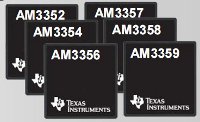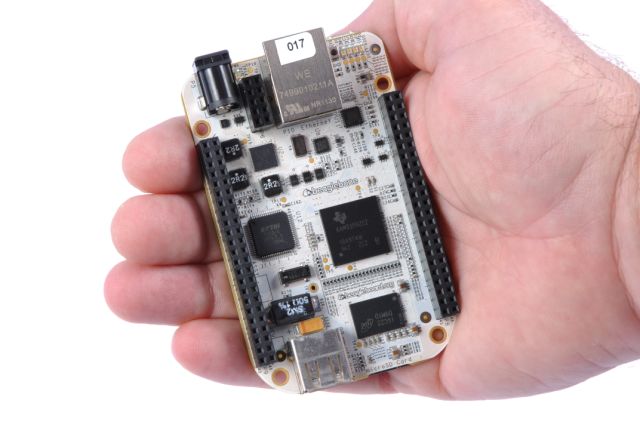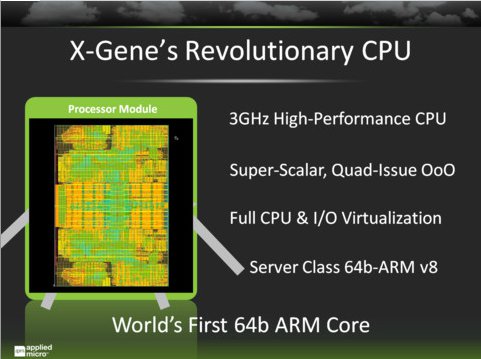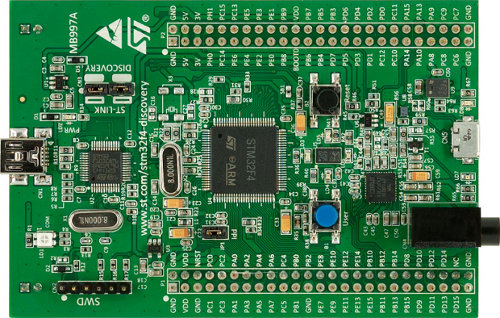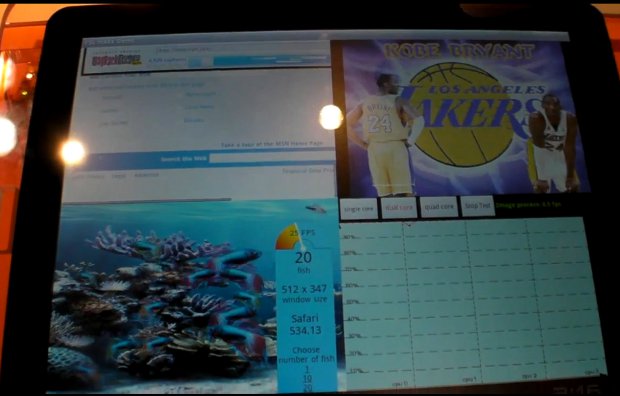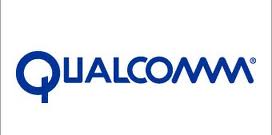Texas Instruments has just announced the new Sitara AM335X Processors and the low cost Beaglebone development board. The low cost Cortex-A8 SoCs start at 5 US dollars per piece and are aimed at upgrading ARM9 solutions (software compatible) and adding new features such as 3D interfaces and touch screen, high resolution displays with faster performance. Texas Instruments says you could take those new upgraded products to market within 6 months thanks to their inexpensive development board (Beaglebone) and complete SDK. There are six models in the Sitara AM335X series: AM3552: Cortex A8 up to 720 MHz. AM3554: Cortex A8 up to 720 MHz with 3D Graphics (PowerVR SGX GPU). AM3556: Cortex A8 up to 720 MHz with programmable real-time unit (PRU) @ 200 Mhz. AM3557: Cortex A8 up to 720 MHz with PRU @ 200Mhz and EtherCat. AM3558: Cortex A8 up to 720 MHz with 3D Graphics and PRU @ […]
BeagleBone: New 89 USD Beagleboard
The BeagleBone is a low-cost, high-expansion hardware-hacker focused BeagleBoard. It is a bare-bones BeagleBoard that acts as a USB or Ethernet connected expansion companion for your current BeagleBoard and BeagleBoard-xM or works stand-alone. The BeagleBone is smaller than the previous version of BeagleBoards (looks like the business of a credit card) and features TI Sitara™ AM3358 Cortex A8 processor clocked at 700Mhz. The BeagleBone is also able to run a full-featured Linux. Here are the current hardware specifications: TI AM3358 ARM Cortex-A8 @ 700 MHz 256 MB DDR2 RAM Board size: 3.4″ x 2.1″ Shipped with 2GB microSD card with the Angstrom Distribution with node.js and Cloud9 IDE Single cable development environment with built-in FTDI-based serial/JTAG and on-board hub to give the same cable simultaneous access to a USB device port on the target processor Industry standard 3.3V I/Os on the expansion headers with easy-to-use 0.1″ spacing On-chip Ethernet, not […]
Applied Micro X-Gene 64-Bit ARMv8 Server-on-Chip Presentation
Applied Micro Showcases World’s First 64-bit ARMv8 Core at ARM Techcon 2011, Santa Clara California. The day ARM announced the first 64-bit ARMv8 instruction set architecture, AppliedMicro unveiled the launch of the industry’s first 64-bit ARM “Server-on-a-Chip” solution. Most of the presentation is used to explain the competitive advantage this platform would bring including TCO reduced by 30%. There is also an (underwhelming) demonstration of X-Gene based on Xilinx Virtex-6 FPGA running Server SoC consisting of ARM-64 CPU complex, coherent CPU fabric, high performance I/O network, memory subsystem along with fully functional SoC subsystem. The FPGA platform and tools will be available for customer evaluation by the first half of 2012. Redhat will be in charge of implementing ARMv8 support in Linux and this will be part of Fedora for ARM in the future. The platform will run LAMP: Linux, Apache, MySQL and Perl/PHP/Python. The silicon will be available in […]
Run 2 OS Simultaneously on ARM (OMAP4) with Codezero Embedded Hypervisor
B Labs, a company specializing in ARM Virtualization, was at ARM Techcon 2011 showcasing Codezero, their Embedded Hypervisor to run multiple Linux OS such as Android and Chrome OS on ARM processors. The main purpose of running 2 operating systems is to separate home and enterprise operating systems in mobile devices so that enterprise data is safe. Charbax (ARMDevices.net) interviewed Bahadir Baldan, founder of B Labs, and showed a demo running 2 Android instances and another running Android and Linux in pandaboard. The overhead is 10 to 15% according to B Labs, so the performance hit is minimal. They have already managed to run 4 OS on quad core processors with good performance. They are not able to run Windows operating systems (e.g. Windows Mobile 7.5/ Windows 8) yet, because Cortex A9 processors lack virtualization extensions. This will however be feasible with Cortex A15 processors as binary virtualization will be available. […]
ST Micro 15 USD STM32F4-Discovery Cortex-M Development Kit
ST Microelectonics promote their Cortex-M series at ARM Techcon 2011 and especially the new STM32F4 series the most powerful cortex M4 MCUs. They also showcase a low cost development board called STM32F4-Discovery that they give away at the exhibition and that can be bought online for 14.90USD from distributors. The evaluation board is based on the STM32F407VGT6 and includes an ST-LINK/V2 embedded debug tool, two ST MEMS, digital accelerometer and digital microphone, one audio DAC with integrated class D speaker driver, LEDs and push buttons and an USB OTG micro-AB connector. A large number of free ready-to-run application firmware examples are available in the STM32F4-Discovery board firmware package to support quick evaluation and development. Key Features of the Development kit: STM32F407VGT6 microcontroller featuring 32-bit ARM Cortex-M4F core, 1 MB Flash, 192 KB RAM in an LQFP100 package On-board ST-LINK/V2 with selection mode switch to use the kit as a standalone ST-LINK/V2 […]
Freescale i.MX6 Quad-Core Benchmark Demo
Freescale is showcasing the performance of their Quad Core ARM Cortex-A9 i.MX6 Quad processor at ARM Techcon 2011. The Freescale i.MX6 reference design runs a demo in Android 3.x (Honeycomb) with four windows: JPEG Decoding Window Web browser rendering and scrolling HTML5 Fish tank CPU Usage real-time chart The 3 windows used for the benchmark are all using software processing (no GPU involved) to show to performance improvement by moving from 1 to 2 and finally 4 cores. The benchmark results are quite impressive as with one core JPEG decoding is about 0.6 frame per second and with 4 cores it can decode 4.2 frames per seconds while other windows also show performance improvement. Freescale says there was little modifications done to make the software work on four core and you don’t even need to have multi-threaded applications to take advantage of 4 cores as the OS will usually take […]
Qualcomm Fast Computer Vision SDK
Qualcomm introduced FastCV (Fast Computer Vision), a mobile-optimized computer vision (CV) library that includes the most frequently used vision processing functions for use across a wide array of Android mobile devices. FastCV provides computationally intensive vision processing APIs, with hardware acceleration and better performance on mobile devices. FastCV is designed for efficiency on all ARM-based processors, but is also especially tuned to take advantage of Qualcomm’s Snapdragon processors (Qualcomm S2 and above). That’s because FastCV for Snapdragon can offload processing onto various subsystems within the processor, whereas FastCV for ARM is limited to acceleration on the CPU. FastCV is the framework at the heart of Qualcomm’s vision-based Augmented Reality (AR) SDK, because AR is much more precise and useful when it’s based on camera input than on location-based estimates. Qualcomm anticipates that FastCV will be used to build additional frameworks that will allow developers of computer vision apps to build […]
ARM Unveils 64-Bit ARMv8 Architecture
ARM has just disclosed the technical of the ARMv8 architecture (to selected partners), featuring 64-bit instruction set support, extended virtual addressing, and backwards-compatible 32-bit support, so that software designed for ARMv7 (Cortex-A family) cores will run on the ARMv8 architecture. Here are the key points of the press release: The ARMv8 architecture consists of two main execution states, AArch64 and AArch32. The AArch64 execution state introduces a new instruction set, A64 for 64-bit processing. The AArch32 state supports the existing ARM instruction set. The key features of the current ARMv7 architecture, including TrustZone®, virtualization and NEON™ advanced SIMD, are maintained or extended in the ARMv8 architecture. … In support of the introduction of the ARMv8 architecture, ARM is working to ensure a robust design ecosystem to support the 64-bit instruction set. The ARM compiler and Fast Models with ARMv8 support have already been made available to key ecosystem partners. Initial […]


